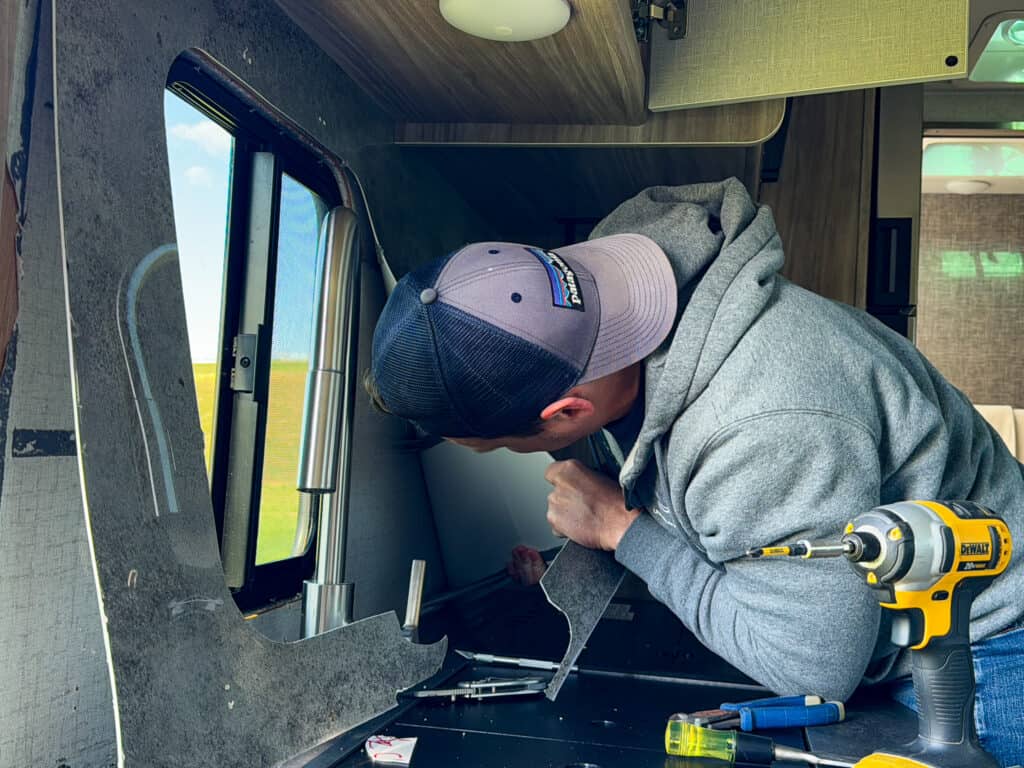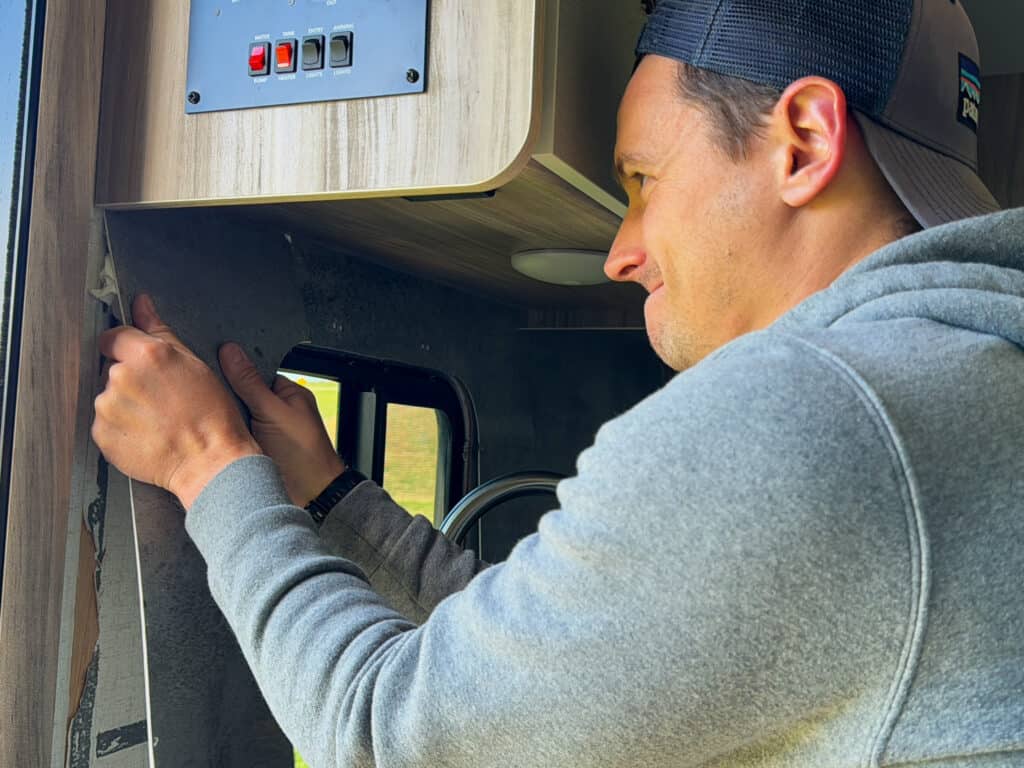How We Changed the Kitchen Backsplash in Our RV | Step-By-Step Guide

Anyone who purchases a camper or travel trailer knows the urge to customize it the moment you bring it home.
When we took ownership of our Winnebago Micro Minnie RV, we spent the first weekend doing numerous projects to really make it ours.
One of those projects was removing the plastic kitchen backsplash and installing a new one that we liked better. Since we purchased ours new, the backsplash was the standard option that was installed during production.
To us, it looked somewhat cheap, and we noticed that it was starting to come off the wall in a few places – perhaps not enough glue by the manufacturer? Regardless, we wanted to personalize the space with a backsplash that fit our style.
So, we decided to do a kitchen tile backsplash with stick and peel tile. We had never used a product like this before, but it turned out to be pretty easy.
In fact, the most difficult part was the task of removing the original backsplash – more on that later.
Considering upgrading your kitchen’s backsplash? We’ve put together this step-by-step guide to share our experience, recommendations, and mistakes we made.
Overall, it took us about two hours.
Tools Used For Upgrading Our Camper’s Kitchen Backsplash
Before you do anything, make sure you have all the tools and materials you’ll need:
- Scissors
- Exacto Knife
- Handheld Vacuum – this is one of our favorite RV purchases!
- Drill
- Peel and Stick Tiles
- Pliers
- Chisel
- Box Knife
- Sharpie
- Spray Adhesive – a note here that we did not use this, but we have heard from others who did the peel and stick tile that they recommend it
We read others experiences where they used an additional adhesive to spray on before sticking on the tile. We opted to not do this because we didn’t think it was necessary and wanted to be able to take it off later if needed.
Below are all the steps we followed to replace our plastic backsplash.

Step-By-Step Instructions For Installation
Step One: remove the window trim, blinds, and valance
You won’t need to take out the entire window, just the metal trim piece. You’ll see there are several screws along the edge of the trim – remove the screws and it will come right out.
To remove the valance, locate the two screws on the top going into the cabinet. Remove them and it will come off.
To remove the blinds, first you have to remove the blind panel from the bracket. You can do this by popping it out. It’s takes a little wiggling. Then, remove the screws from the bracket.
We did not put the blinds or valance back on, but if you plan to, make sure you mark the holes when installing the tile if you don’t want to create new holes when re-installing.

Step Two: remove trim piece
On our camper, there is a trim piece between the door trim and the backsplash. Use a chisel to pry the trim piece away from the wall.
Then, use pliers to remove the brad nails if any are left in the wall.
Unless you tile all the way to the door jam, you will need to put this back on, so be conscious of where it goes when tiling.
We decided not to put the backsplash all the way to the door jamb because we thought it might look weird with the space above between the cabinet and the door. That’s just personal preference – you might feel differently!

Step Three: cut through the silicone caulking
Use a box knife to cut away the silicone caulking along the countertop and right wall. For us, there was no silicone along the left side or the top.

Step Four: remove the plastic backsplash
We used a chisel to start prying the backsplash from the wall. We found that the area along the bottom window frame was easiest to start.
Behind the plastic backsplash, there were some areas with glue, but it is sporadic and will be different for everyone. You will likely find there are areas that come up easily and others that need more pulling.

While pulling the plastic away from the wall, we used an exacto knife to cut away the glue in hard to reach places.
We decided to cut the backsplash into two sections to make it easier to pull them out. We did our cut where the faucet is as to not damage it while pulling the plastic off.
We don’t recommend cutting it into more than three sections as you will lose traction when pulling it off.
You can see in the below picture the glue that we were cutting away as we went.

Once we cut the plastic into two sections, we found the right side of the piece to be easier to remove than the left side, but that was because there was less glue.
It may be different for you depending on how it was done during the build out.

The top of the plastic backsplash was the most difficult part to remove.
This is because it goes up into the cabinet about 1/2 inch. For us, the trickiest section was the top left corner.
Our recommendation is to just be patient and careful as you keep moving it back and forth.
It took a little bit but it eventually came loose for us.

Step Five: remove the glue
Once you have the backsplash removed, go through and take off as much of the glue as possible.
We used a putty knife to flatten and smooth out sections where there was a lot of glue that was difficult to remove.
We found it to be fine that not all of the glue was taken off. This is personal preference – some people say to take your time removing all the glue, but we didn’t find it necessary.


At this point, we cleaned up the counter, especially where it connected to the wall because there were pieces of glue and plastic.
We love the handheld, cordless vacuum we bought for our camper. We use it all the time to clean up the floor and counter tops, and it worked great for cleaning up the backsplash mess.
Step Six: add the new backsplash
We really like the tile we purchased – it has a light grey grout, which was a nice accent with the grey cabinets and stainless steel appliances.
For our kitchen space, we needed just one package, which came with ten sheets.
Each sheet comes with serrated edges on both sides. The instructions recommended to start on the right side. You will need to cut the tiles off to create a straight edge.
We started on the bottom right corner.
Now, we have heard from others who did the peel and stick tile that they used a spray adhesive when placing the tiles onto the wall. We opted not to do this – partly because we keep our camper in a climate controlled storage facility, so we aren’t as worried about the cold and hot weather messing with the tile. If you want to be cautious, go for it and use the adhesive!

When sticking on the tile, we first stuck down the bottom layer and then accordioned it upwards.
If you initially place the first layer it and it is not straight, you can pull it off and place it again. However, once you put the entire sheet on, it is hard to pull it off without damaging some of the edges.
When we put the second sheet on to the left of the first sheet, we let the right edge tiles go wherever they naturally fell. As we moved on, we realized it was better to guide the tiles in place along the edge of the sheet you were connecting it to.
You can see in the pictures, there are a couple of areas where the grout looks thicker, and that was because we weren’t sticking the new sheet directly onto the grout of the sheet that we were connecting it to.
Go slow and take your time to get it right.

Once the sheets were in place, we put pressure over them to make sure they were stuck well.
The mistake we made was that we started with a couple of sheets on the bottom and then went upwards. Don’t do this! It caused issues with the tiles being straight and lining up horizontally as we went along.
Start by putting all the tiles/sheets along the bottom and then work your way up one row at a time.

When you get to the window, we recommend putting the sheet up and identifying about where the window will be. Because there was a plastic sheet on both sides of the tile, we used a sharpie to draw an approximate outline of the window.
We then cut the sheet of tiles along the line. You can use the tiles you cut away to piecemeal tiles as needed when you put the tiles around the left side of the window frame.
For the excess tile along the window, use the box cutter to cut it away. This does not have to be perfect because you will be putting the window trim on it.

Again, as we moved around the window, we would use the sharpie to mark off where we should cut the sheets to be just a little bigger than the area we needed the tile in.
This gave us excess tiles to use as we moved along.

The most difficult areas to tile were around the window and the top along the cabinets.
For the top, we cut out individual tiles with a scissor, cut them in half, and added them in one at a time.
Doing this method, we decided the best course of action was to caulk along the outline when we were done. This allowed us to make it so that the top was not perfect and could be covered and filled in with caulk.

We decided not to re-install the valance.
Instead, we are going to look into window film options for privacy. We are also going to look into a curtain rod option with custom size curtains.

Kitchen Backsplash Installation Takeaways
We are very happy with how our new backsplash turned out! It really brightens and modernizes the space.
Our main suggestions to you are to be patient and go slow and to start with the entire bottom row and work upwards one row at a time.
You got this!
More Travel Trailer Projects
We love our DIY camper projects – read about how we upgraded our vent fan!


One Comment
Comments are closed.